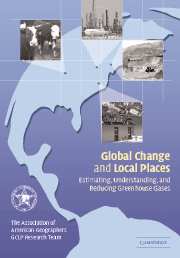Book contents
- Frontmatter
- Contents
- List of contributors
- Foreword
- Preface
- Acknowledgments
- Part One Global change and local places
- Part Two Learning from localities
- Part Three Beyond Kyoto I: greenhouse gas reduction in local places
- 7 Changing places and changing emissions: comparing local, state, and United States emissions
- 8 Explaining greenhouse gas emissions from localities
- 9 Attitudes toward reducing greenhouse gas emissions from local places
- 10 Reducing greenhouse gas emissions: learning from local analogs
- Part Four Beyond Kyoto II: greenhouse gas reduction potentials and strategies
- Index
- References
7 - Changing places and changing emissions: comparing local, state, and United States emissions
Published online by Cambridge University Press: 31 July 2009
- Frontmatter
- Contents
- List of contributors
- Foreword
- Preface
- Acknowledgments
- Part One Global change and local places
- Part Two Learning from localities
- Part Three Beyond Kyoto I: greenhouse gas reduction in local places
- 7 Changing places and changing emissions: comparing local, state, and United States emissions
- 8 Explaining greenhouse gas emissions from localities
- 9 Attitudes toward reducing greenhouse gas emissions from local places
- 10 Reducing greenhouse gas emissions: learning from local analogs
- Part Four Beyond Kyoto II: greenhouse gas reduction potentials and strategies
- Index
- References
Summary
The greenhouse gas emission inventories that currently inform abatement policy discussions have been developed almost exclusively from national-scale data, leavened only rarely with state or provincial inventories. Yet much of the capacity to abate greenhouse gas emissions necessarily resides within local institutions and communities. Policy may be debated and established at national and global scales, but it can be implemented only primarily by local action. This chapter examines how much information is lost when greenhouse gas emissions are estimated only at national scales (the United States in this instance) rather than at state or local levels, as in the four Global Change and Local Places study areas. That information may be critical to linking global and national policies to local actors and behavior.
Comparison of differences in the composition of greenhouse gas emission sources at three nested scales (national, state, local) for the four Global Change and Local Places study sites reveals good agreement in the by-gas composition of greenhouse gas emissions among national, state, and local inventories. Considerable differences are evident, however, in the by-source composition of greenhouse gas emissions among national, state, and local inventories. Geographical sovereignty is evident with respect to the composition of emissions, but geographical sovereignty does not hold for the sources of those emissions, suggesting that continuous monitoring of state and local emissions sources is needed to track geographical and temporal deviations from national trends.
Fugitive emissions and global perspectives
Human-induced greenhouse gases, once released into the atmosphere, recognize no boundaries.
- Type
- Chapter
- Information
- Global Change and Local PlacesEstimating, Understanding, and Reducing Greenhouse Gases, pp. 143 - 157Publisher: Cambridge University PressPrint publication year: 2003



